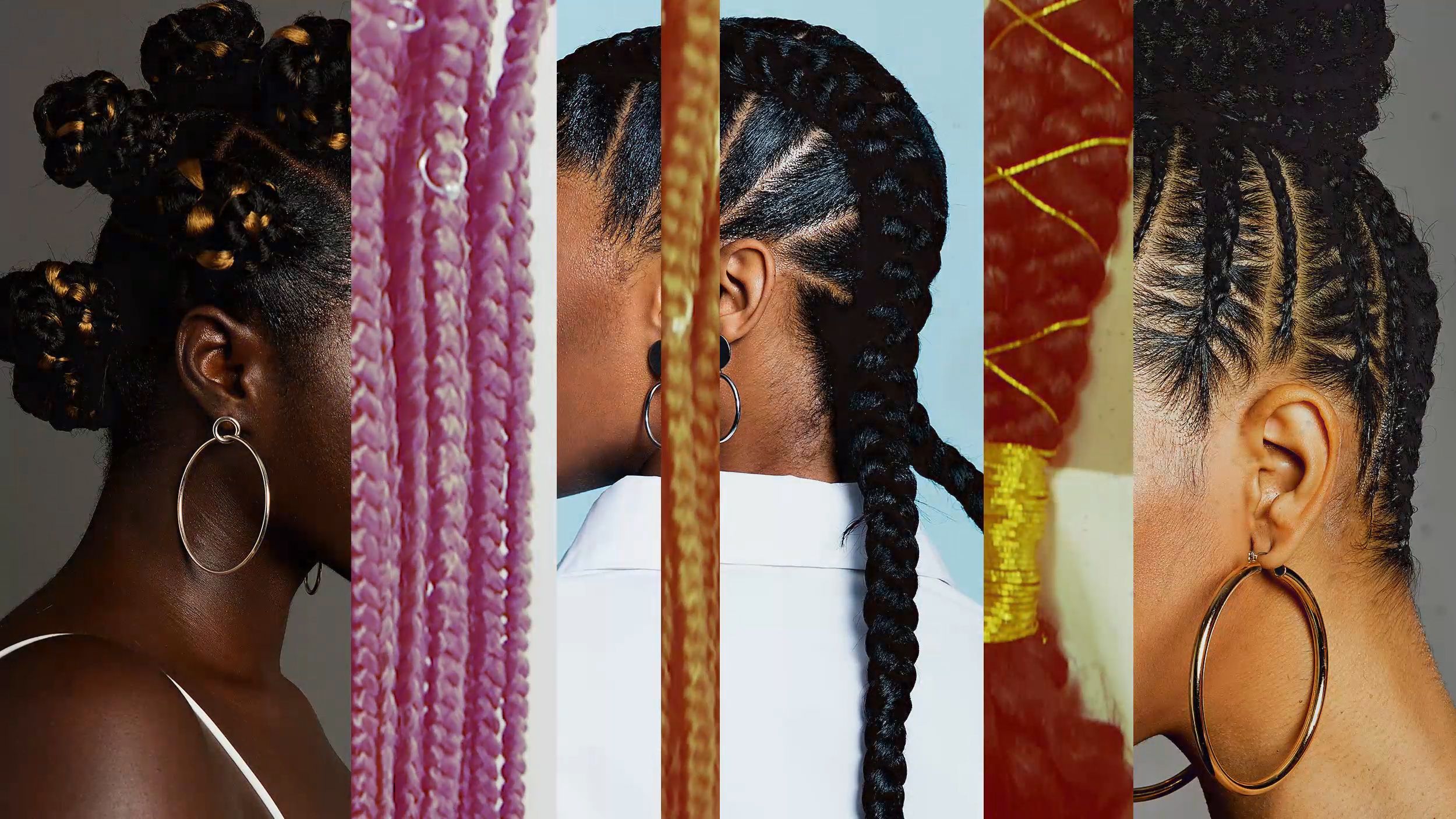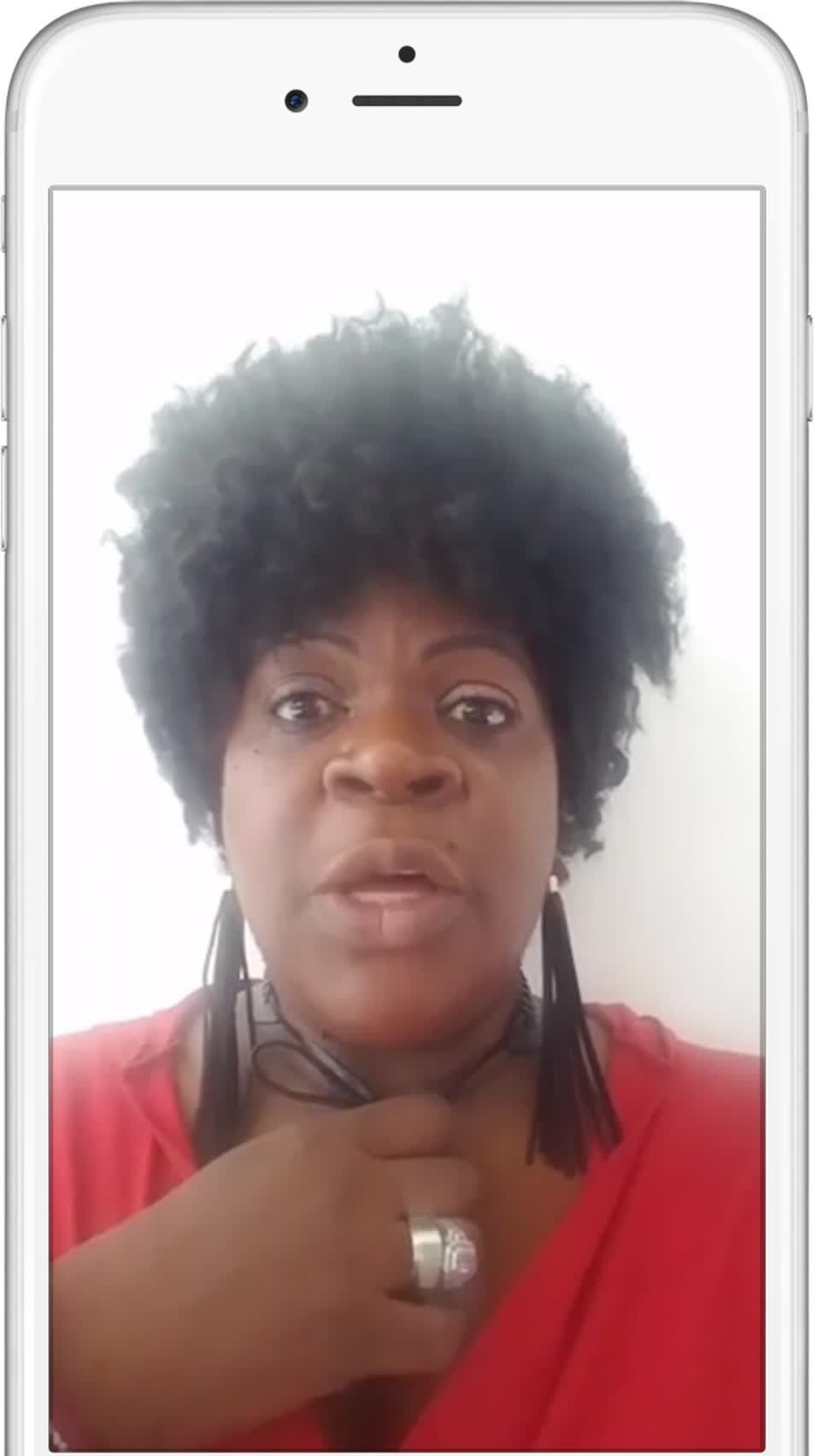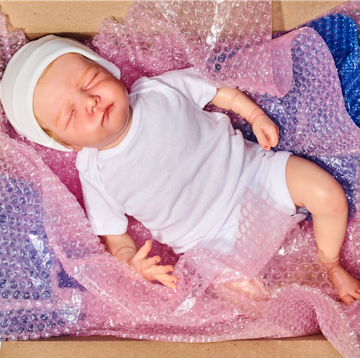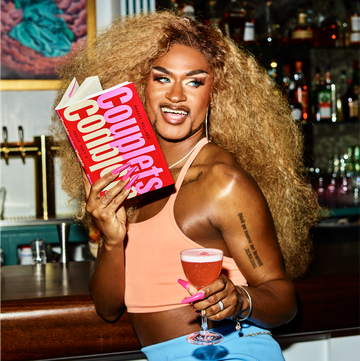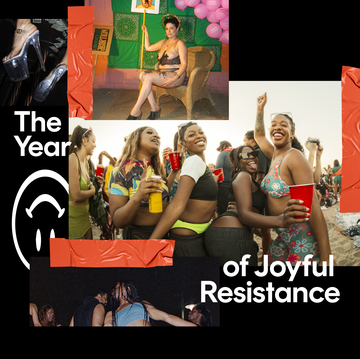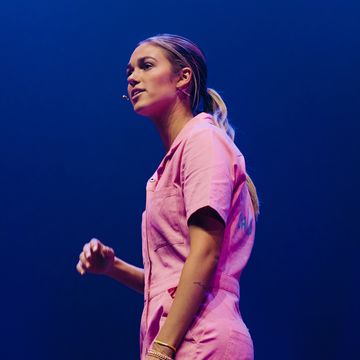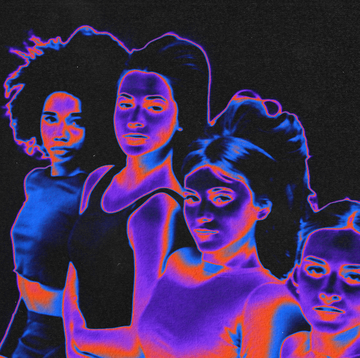Shuffling along the cold airport floor with no shoes on, I stepped into the scanner and raised my arms. I was nervous. Growing up in a low-income, single-parent household, I had always viewed travel as an unattainable luxury, and now here I was, taking my second flight ever at age 24. My first, just two days earlier, had been fine, but this time, as I exited the scanner, a TSA agent stopped me. She needed to search my hair. Not a full-body pat-down, just my hair.
I’m black and have naturally curly hair — that day I wore it straightened, pulled back into a low ponytail. I'm sure hundreds of white women passed her by with the exact same hairstyle that day. I wondered if she'd stopped them, too. The agent put on a pair of blue gloves and patted three times across the top of my head. Then she waved me through.
Unsettled, I gathered my belongings and scurried to my gate, trying to collect my thoughts. Weren’t they supposed to have stopped searching black women’s hair? I thought, remembering articles about the TSA’s response to black women’s hair-search complaints filling my newsfeed a few years ago. There, on a hard plastic airport chair awaiting my second flight ever, I started Googling.
"TSA Will Stop Searching Black Women's Natural Hair," Essence, 2015; "TSA Says It Will Stop Touching So Many Black Women's Hair," HuffPost, 2015; "The TSA Agrees to Stop Searching Women's Hair During Airport Screenings," Business Insider, 2015; "The TSA Will Stop Singling Out Black Women For Hair Searches," BuzzFeed News, 2015.
And yet I, a black woman, had just had my hair searched by the TSA in 2017.
When I got home and looked into it further, I learned that, in April 2014, the American Civil Liberties Union of Northern California had filed a complaint on behalf of Malaika Singleton, a black female neuroscientist employed by the California State Senate at the time, who felt she was unfairly targeted for TSA hair searches on the basis of her race. Nearly a year later, the ACLU reached an agreement with the TSA and issued a press release in March 2015.
“Both the United States and California Constitutions prohibit unreasonable searches and selective enforcement of the law based on race,” read part of the release. “In this case, TSA agents were unable to provide a uniform reason to justify these searches when asked to articulate such a policy.” Novella Coleman, a staff attorney with the ACLU of Northern California, who had also complained about having her hair searched by the TSA in 2012, stated, “The humiliating experience of countless black women who are routinely targeted for hair pat-downs because their hair is 'different' is not only wrong, but also a great misuse of TSA agents' time and resources.”
The agreement stipulated that the TSA would conduct training for agents on the “TSA's commitment to race neutrality in its security screening activities with special emphasis on hair pat-downs of African-American female travelers” at the Minneapolis and Los Angeles airports where the incidents outlined in the ACLU complaint took place. They also promised to “specifically track hair pat-down complaints…from African-American females throughout the country to assess whether a discriminatory impact may be occurring at a specific TSA secured location.” Contrary to media reports, they did not agree to stop searching black women’s hair altogether.
But how effective had the training and complaint tracking really been? How many other women had experienced searches after 2015 like I had? I filed two Freedom of Information Act requests to find out, the first for background on hair-search complaints at specific airports; the second for the TSA’s full list of hair-search complaints maintained by the agency’s Multicultural Branch of the Office of Civil Rights & Liberties, Ombudsman and Traveler Engagement.
There I got my answer: Between May 13, 2015 and March 13, 2017, 98 black women filed hair-search complaints with the TSA, according to the records from the Multicultural Branch. That number is likely a small fraction of the women who felt they were inappropriately searched, as my FOIA request for complaints filed regarding specific airports in several cities uncovered an additional 85 complaints, and of course many women may not know they can file a complaint at all. While the TSA states on its website that searches are not conducted with regard to race, these complaints from black women across the country raise serious questions about whether that's true.
Reba Perry-Ufele’s hair search was more invasive than mine. She and her 12-year-old daughter, Egypt, were catching a flight from LAX in April 2017 when TSA agents — officially called Transportation Security Officers (TSOs) — pulled Perry-Ufele aside to search her crochet braids. Perry-Ufele found it odd that the white woman in front of her, whose hair was “all over the place,” wasn’t stopped. She told the TSO that she didn’t want her hair searched. But the agent claimed it was protocol, Perry-Ufele says, and began pulling Perry-Ufele’s braids apart, asking about the extensions that were added to make them thicker.
“I was so embarrassed, because not only did she humiliate me but she did it in front of the other people,” Perry-Ufele explains. “And she literally ripped my braids apart until they were a mess and I had to take them out when I got home.” Perry-Ufele says she emailed a letter to TSA, but did not receive a response.
As I read through the TSA’s list of black women’s hair-search complaints, I saw the same refrain over and over: That the complainant believed her hair was patted down specifically due to race, and that she found the experience demeaning.
“[I] watched a few other women walk through without having their hair searched. My hair is in locks that were pulled back from my face,” one woman who passed through the Columbia Metropolitan Airport in South Carolina wrote in her September 16, 2016 complaint. “I felt violated. I thought TSA agreed to stop searching black women’s hair. I’m looking into taking legal action.”
“Pulled aside after the full body screening and held up so a TSA agent could remove my beanie and run their hands through my hair,” another woman wrote in an August 28, 2016 complaint about the Mineta San Jose International Airport in California. “My hair is chin-length and natural/loosely curled (Black). Meanwhile, other people with hats and more volume in their hair were cleared. What is the basis for picking through people’s hair? This was EMBARRASSING.”
“A white woman with a bun in her hair was let through after the X-ray screen. I, of black and Spanish descent, with the same amount of hair and in a bun, went through the screening and was stopped saying that the agent needed to check my back,” a complainant who was searched at John F. Kennedy airport in New York wrote on April 19, 2016. “I was not informed that she was going to inspect my hair, and she squeezed my bun with the same dirty gloves she had on from screening other passengers.” (Agents are supposed to announce hair searches, but are only required to change gloves between complete pat-downs — not hair-only checks — or when requested by the passenger.)
“To say the least, I was violate[d],” the JFK passenger continues. “This is racial profiling. I asked both agents present why the white female passenger was not screened the same way. The female agent ignored me and the male agent just smiled nervously.”
Black hair has long been politicized in the United States. Historically, braids and head rags carried post-emancipation cultural connotations that the wearer was less educated than someone with straight hair, according to Lori L. Tharps, associate professor at Temple University and co-author of Hair Story: Untangling the Roots of Black Hair in America. Such misinterpretations are unfortunately not just relics of the past. It was only last year that the military decided to roll back hairstyle restrictions on black Army women. But before Europeans explored the western coast of Africa in the 1400s, intricate hair was a status symbol there, and only special stylists were allowed to look after it.
“There’s historical precedent for black women and men to not let anyone touch their hair,” Tharps says. “And those memories and traditions did not get erased just because Africans were captured and enslaved and brought to another land.”
Beyond judgment of black hair, hair searches exacerbate the stereotype that black people are inherently criminal. Judith Heilman, who filed a complaint about a hair search at the Bozeman Yellowstone International Airport in Montana in August 2015, explains that there’s a level of discomfort — and a reinforcement of racist ideas — that comes when other travelers, especially white passengers, stare at a person of color who’s been stopped by TSA.
“The ramifications of these hair pat-downs are really big on a personal level,” Heilman says, “and Homeland Security doesn’t seem to care about that.” (Heilman received a letter from the TSA explaining that her screening appeared to be consistent with standard procedure, and recommending that she contact a passenger support specialist or supervisor if she had concerns in the future.)
Following the 2015 TSA agreement, Coleman, the ACLU lawyer, says she attended a TSA manager re-training session at LAX airport, where she says the agency emphasized that, due to its size, it would be difficult to ensure consistency at each airport for each traveler. Coleman had to agree not disclose any security procedures she saw during the training in order to attend it, but she says she was alarmed that the agency, judging from its response to Singleton’s complaint, didn’t seem to consider seeking less intrusive alternatives like having people manipulate their own hair in front of an agent to show there’s nothing hidden. Coleman says she has since witnessed some airports letting customers pat their own hair.
“To me, the fact that some airports have found less intrusive alternatives makes it really bizarre that all of the airports just don’t do that,” Coleman says. “If one’s doing it, then obviously there’s nothing in that practice that’s inconsistent in TSA’s policy and its goal of protecting security, so why not have all of them do that given that it’s less intrusive?”
When asked about the agency's efforts to find alternative hair-search methods, a TSA spokesperson wrote in an email, “TSA has explored alternative methods and continues to pursue emerging technologies in an effort to provide a non-intrusive way to resolve AIT alarms, including those caused by hairstyles and headwear.”
After my own hair search, I wondered why the scanner wasn’t sufficient to determine whether I was hiding anything dangerous, and other women I spoke with for this story echoed that confusion. According to a September 2012 Congressional Research Service report, TSA has used millimeter wave systems to scan passengers’ bodies since 2007. In 2011, they began upgrading the scanners with a privacy software called Automated Target Recognition (ATR) so agents would not be able to see images of people's figures. Agents now see only a generic outline of a body and get vague alerts if the machine detects an object present.
“With the privacy mode, it’s rare that it will give you enough detail to show you what it is, if anything. It will show you a darker spot,” says Matt Pinsker, an attorney and adjunct professor at Virginia Commonwealth University who previously worked with for the Threat Assessment Division of the Security Operations Office for TSA and specializes in national security. “That could be anything. It could be a paperclip or something else.” Items that are visible, like necklaces, can be cleared by a TSO immediately, but according to TSA training documents, elaborately styled hair that might contain objects may require a “limited pat-down.” None of the policies outlined in the training documents explain why hair like mine — straight, secured with an elastic band and no clips — would be flagged for a search.
I spoke with C., a former TSO who preferred not to be identified, who told me that in his experience, hair searches were evenly applied to people of all races — and that these searches happen for good reason. During his nine-year tenure at the agency from 2002 to 2011, C. recalls that TSA officers regularly collected prohibited items like knives, guns, scissors, and other potentially dangerous objects found during searches.
“I’ve seen pictures where people have actually glued heroin to their scalp and then put a wig on,” C. says. “I don’t want people to think, ‘Oh, there’s no reason’ — no, there’s an actual reason for everything that they’ve done.”
One of the hair-search complaints I read supports C.’s assertion that TSA officers are often taking cues from the body scanners, but suggests that racial bias still slips in.
“I was going through the body scanning machine… My hair was worn in a curly protective style so it is full around my face,” read a report from a JFK passenger from February 2016. A TSO “then told me that she had to pat down my hair, because they found an anomaly. I told the agent that what she was doing was potentially unconstitutional, as several white women with longer, straighter hair were not having their hair patted down. I told the agent that I am not refusing the pat down, only [informing] her that it is problematic, as it targets black women disproportionately.”
“The agent then became agitated, [refused] to [listen] to what I was saying, talked over me, and yelled for a supervisor, [but] one never came,” the complainant continued. “She repeatedly said, ‘I don’t have time for this, ma’am. I’m just doing my job. It’s the machine … She grabbed my hair all around my head and then told me to go. I felt singled out and embarrassed. I went to complain to the two officers at the desk behind the checkpoint. They listen[ed] to my complaint, but told me that it’s what the machine showed.”
The TSA’s responses to black women’s hair-search complaints reveal that this is a known issue. After receiving a December 14, 2016 complaint that suggested that the agency “stop searching and singling out black women for wearing braids, locs, and weaves,” a TSA customer service manager explained in his December 23, 2016 response that “natural hair, in dreadlocks, have been known to be identified by the body scanner as an area that needs to be checked due to how dense the hair can be. Also, with enough volume, it may need to be checked by officers merely from their visual inspection of the passenger to ensure nothing can be hidden in the hair.”
This is where, it seems, problems arise. Several government reports have pointed out the ineffectiveness of not only TSA’s body-imaging technology, but also the agency’s overall search methods. In September 2017, the Department of Homeland Security’s Office of the Inspector General published a one-page unclassified summary that found “vulnerabilities with TSA’s screener performance, screening equipment and associated procedures.” (A spokesperson for the agency said in an email that “the body scanners and millimeter wave systems already deployed in airports have been updated” since the release of the 2012 report, but declined to say how.)
Given the ineffective technology, TSOs are forced to cover for the machines’ inadequacies, leaving room for human bias. Pinsker, the national security expert and professor, says TSOs are trained in Screening of Passengers by Observation Techniques (SPOT), a behavioral detection method that focuses on determining if someone may be dangerous based on body language rather than race.
But Rachel Hall, author of The Transparent Traveler: The Performance and Culture of Airport Security and associate professor at Syracuse University, argues that these behavioral search methods are not racially neutral. Because certain groups have different physical or stylistic characteristics — veils or opaque hairstyles, for example — they can be seen as threatening from the TSA’s viewpoint because they are out of the norm, Hall says. And then there’s the fact that the TSA requires passengers to stand in a “hands up, don’t shoot” pose in the scanner, which carries strong associations of danger for black Americans.
“Groups of people who’ve been historically treated as suspects fear [being viewed as a suspect] more than those who’ve have enjoyed the privilege of being innocent until proven guilty historically,” Hall says. That fear can read as suspicious behavior by TSOs, triggering a cycle of discrimination.
When I requested an interview with the TSA in July 2017 to discuss their screening practices, the agency declined, but a spokesperson said in a statement that the agency “does not profile based on race, gender, religion, or any other identity characteristic.” A TSA spokesperson also declined my February 2018 interview request, because “it’s a busy time for the agency right now.”
When the TSO finished searching my hair, I didn’t ask to speak with her supervisor, or file a complaint, or even ask her why. I grew up in and near Detroit, where stories about worrisome experiences with law enforcement passed through my community. I remember my father telling me about being hassled by police. I remember being 12 and sitting extremely still as an officer spoke through the window to my uncle in the driver’s seat. I remember, as an older teen, keeping a close eye on an officer as he walked back and forth between my mother’s red Ford Explorer and his police car, so focused I didn’t speak until after we drove off. There was subtle toxic fear in the air like cigarette smoke. Don’t ask for the officer’s badge number. Don’t file a complaint. The focus, then and now, was getting home. I know of enough unarmed black women and men who’ve been shot to death to understand that I needed to comply.
The damage these searches inflict upon black women extends beyond inconvenience. They warp the public perception of black and brown people — that they are different and to be feared — and for many black women, who may already fear law enforcement and places of privilege, like the airport, they make air travel all but prohibitive.
Coleman, the ACLU lawyer, encourages black women who experience intrusive hair searches to continue filing reports with the TSA, even after they get home safely. She thinks the TSA has taken the issue seriously but struggles to stop bias across its large cadre of officers. “In order for TSA to remain responsive, it is imperative that passengers provide TSA with direct feedback if they experience discriminatory or invasive search practices,” she says.
Riding the plane was scary enough for me, but being pulled aside for unclear reasons, I felt the same paralysis — the fear that if I wasn’t perfectly compliant I could get into serious trouble or be harmed — as I did as a teenager in the back seat, watching my mother being questioned by police.
It will be a long time before I fly again.
Travelers who have grievances with their TSA experience can file complaints via the TSA website.
Follow Tatiana on Twitter.
